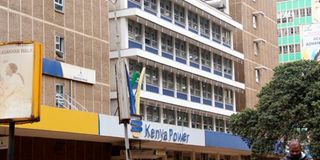Kenya Power urges women to tender for AGPO contracts

Kenya Power offices on Aga Khan Walk, Nairobi.
What you need to know:
- The firm has set aside Sh3.7 billion of its procurement budget in the current financial year to women, youths and persons living with disability.
- In the last financial year, it set aside Sh1.6 billion to the three groups, but only Sh480 million was taken up.
Kenya Power is partnering with women’s groups to raise awareness of its procurement opportunities.
This follows low uptake of allocations to women, youth and persons with disabilities (PWDs) under the Access to the Government Procurement Opportunities (AGPO) programme.
The company, in a press release, noted that of the three groups, women lag behind. To reverse this scenario, it is carrying out pre-bid conferences where bidders are taken through various tender requirements, supplier registration process, and uploading of documents on the procurement portal.
The firm has set aside Sh3.7 billion of its procurement budget in the current financial year to these groups. In the last financial year, it set aside Sh1.6 billion to women, youth and PWDs, but only Sh480 million was taken up.
The state agency blamed the slow uptake on lack of duly registered and compliant business enterprises, low understanding of the e-procurement system and failure to ensure the goods targeted for procurement meet the requisite tests.
“The opportunities exist but women feel that this is a very technical area and as a result, the uptake of these tenders has been very low. The few women who are getting the tenders perform very well by giving the best to the Company,” said Dr John Ngeno, Kenya Power’s general manager, Supply Chain.
Also read: Smart procurement empowers women
Dr Ngeno called on the groups to partner with Kenya Power in workshops and other training events where knowledge of e-procurement and opportunities is shared. “By reaching out, we can have many of them taking up the tenders. This will help raise the number of women suppliers. We are sensitising them to procurement processes and creating awareness of existing opportunities.”
To enhance women’s economic empowerment, the government in 2013 launched the AGPO programme, which seeks to have women, youths and persons with disabilities access 30 per cent of its procurement opportunities. However, women have yet to fully benefit.
According to a report titled Impact of Kenya’s Access to Government Procurement Opportunities (AGPO) on Women, Youth and Persons Living with Disabilities by Hivos East Africa, women were awarded 52 per cent of government tenders between 2013 and 2016, with the youth bagging 36 per cent and PWDs getting 12 per cent.
The findings also indicate that 41 per cent of the tenders were placed by women-owned firms. However, out of 2,232 tenders, only 172 were awarded to AGPO-registered firms, translating into only 7.7 per cent of legally prescribed 30 per cent.
The report singles out lack of understanding of the bidding process and lack of invoice financing to fund the tenders and late payments after delivery as some of the major challenges faced by women entrepreneurs. Most of the tenders, it adds, are construction-related, while most AGPO firms are registered in the service sector, especially trade.
The analysis of AGPO, according to the report, however, shows that despite its shortcomings, government procurement schemes remain one of the most sustainable efforts towards women's economic empowerment. The aim of AGPO is to facilitate enterprises owned by women, youths and PWDs to participate in government procurement.
Some reports have blamed the programme for failing to meet the expectations set by the government, with few groups benefitting. A report by the Institute of Social Accountability showed that 35 per cent of AGPO firms face corruption hurdles when trying to access the opportunities, 22 per cent face delayed payments, while a further 10 per cent faced market fluctuations. In addition, nine per cent and 13 per cent respectively had issues with bureaucracy and lack of capital respectively.





